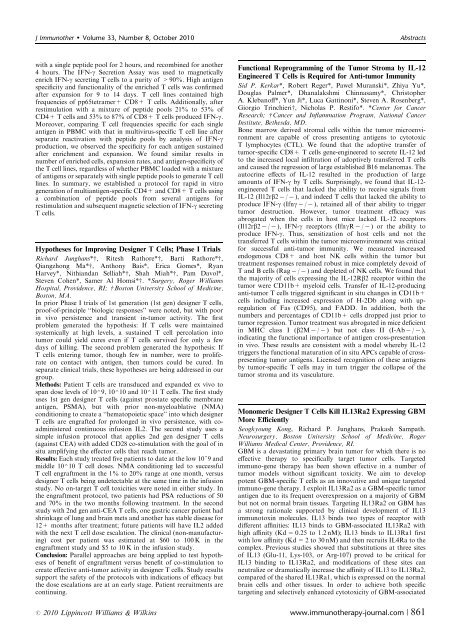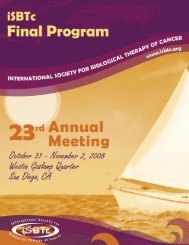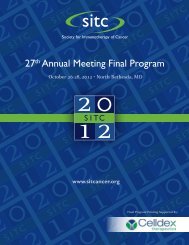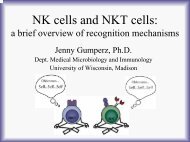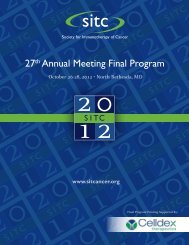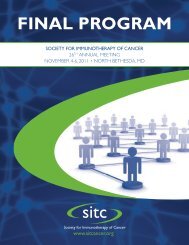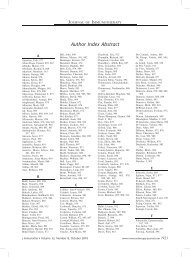Abstracts for the 25th Annual Scientific Meeting of the International ...
Abstracts for the 25th Annual Scientific Meeting of the International ...
Abstracts for the 25th Annual Scientific Meeting of the International ...
Create successful ePaper yourself
Turn your PDF publications into a flip-book with our unique Google optimized e-Paper software.
J Immuno<strong>the</strong>r Volume 33, Number 8, October 2010<br />
<strong>Abstracts</strong><br />
with a single peptide pool <strong>for</strong> 2 hours, and recombined <strong>for</strong> ano<strong>the</strong>r<br />
4 hours. The IFN-g Secretion Assay was used to magnetically<br />
enrich IFN-g secreting T cells to a purity <strong>of</strong> >90%. High antigen<br />
specificity and functionality <strong>of</strong> <strong>the</strong> enriched T cells was confirmed<br />
after expansion <strong>for</strong> 9 to 14 days. T cell lines contained high<br />
frequencies <strong>of</strong> pp65tetramer+ CD8+ T cells. Additionally, after<br />
restimulation with a mixture <strong>of</strong> peptide pools 21% to 53% <strong>of</strong><br />
CD4+ T cells and 53% to 87% <strong>of</strong> CD8+ T cells produced IFN-g.<br />
Moreover, comparing T cell frequencies specific <strong>for</strong> each single<br />
antigen in PBMC with that in multivirus-specific T cell line after<br />
separate reactivation with peptide pools by analysis <strong>of</strong> IFN-g<br />
production, we observed <strong>the</strong> specificity <strong>for</strong> each antigen sustained<br />
after enrichment and expansion. We found similar results in<br />
number <strong>of</strong> enriched cells, expansion rates, and antigen-specificity <strong>of</strong><br />
<strong>the</strong> T cell lines, regardless <strong>of</strong> whe<strong>the</strong>r PBMC loaded with a mixture<br />
<strong>of</strong> antigens or separately with single peptide pools to generate T cell<br />
lines. In summary, we established a protocol <strong>for</strong> rapid in vitro<br />
generation <strong>of</strong> multiantigen-specific CD4+ and CD8+ T cells using<br />
a combination <strong>of</strong> peptide pools from several antigens <strong>for</strong><br />
restimulation and subsequent magnetic selection <strong>of</strong> IFN-g secreting<br />
T cells.<br />
Hypo<strong>the</strong>ses <strong>for</strong> Improving Designer T Cells; Phase I Trials<br />
Richard Junghans*w, Ritesh Rathore*w, Barti Rathore*w,<br />
Qiangzhong Ma*w, Anthony Bais*, Erica Gomes*, Ryan<br />
Harvey*, Nithiandan Selliah*w, Shah Miah*w, Pam Davol*,<br />
Steven Cohen*, Samer Al Homsi*w. *Surgery, Roger Williams<br />
Hospital, Providence, RI; w Boston University School <strong>of</strong> Medicine,<br />
Boston, MA.<br />
In prior Phase I trials <strong>of</strong> 1st generation (1st gen) designer T cells,<br />
pro<strong>of</strong>-<strong>of</strong>-principle ‘‘biologic responses’’ were noted, but with poor<br />
in vivo persistence and transient in-tumor activity. The first<br />
problem generated <strong>the</strong> hypo<strong>the</strong>sis: If T cells were maintained<br />
systemically at high levels, a sustained T cell percolation into<br />
tumor could yield cures even if T cells survived <strong>for</strong> only a few<br />
days <strong>of</strong> killing. The second problem generated <strong>the</strong> hypo<strong>the</strong>sis: If<br />
T cells entering tumor, though few in number, were to proliferate<br />
on contact with antigen, <strong>the</strong>n tumors could be cured. In<br />
separate clinical trials, <strong>the</strong>se hypo<strong>the</strong>ses are being addressed in our<br />
group.<br />
Methods: Patient T cells are transduced and expanded ex vivo to<br />
span dose levels <strong>of</strong> 10 4 9, 10 4 10 and 10 4 11 T cells. The first study<br />
uses 1st gen designer T cells (against prostate specific membrane<br />
antigen, PSMA), but with prior non-myeloablative (NMA)<br />
conditioning to create a ‘‘hematopoietic space’’ into which designer<br />
T cells are engrafted <strong>for</strong> prolonged in vivo persistence, with coadministered<br />
continuous infusion IL2. The second study uses a<br />
simple infusion protocol that applies 2nd gen designer T cells<br />
(against CEA) with added CD28 co-stimulation with <strong>the</strong> goal <strong>of</strong> in<br />
situ amplifying <strong>the</strong> effector cells that reach tumor.<br />
Results: Each study treated five patients to date at <strong>the</strong> low 10^9 and<br />
middle 10 4 10 T cell doses. NMA conditioning led to successful<br />
T cell engraftment in <strong>the</strong> 1% to 20% range at one month, versus<br />
designer T cells being undetectable at <strong>the</strong> same time in <strong>the</strong> infusion<br />
study. No on-target T cell toxicities were noted in ei<strong>the</strong>r study. In<br />
<strong>the</strong> engraftment protocol, two patients had PSA reductions <strong>of</strong> 50<br />
and 70% in <strong>the</strong> two months following treatment. In <strong>the</strong> second<br />
study with 2nd gen anti-CEA T cells, one gastric cancer patient had<br />
shrinkage <strong>of</strong> lung and brain mets and ano<strong>the</strong>r has stable disease <strong>for</strong><br />
12+ months after treatment; future patients will have IL2 added<br />
with <strong>the</strong> next T cell dose escalation. The clinical (non-manufacturing)<br />
cost per patient was estimated at $60 to 100 K in <strong>the</strong><br />
engraftment study and $5 to 10 K in <strong>the</strong> infusion study.<br />
Conclusion: Parallel approaches are being applied to test hypo<strong>the</strong>ses<br />
<strong>of</strong> benefit <strong>of</strong> engraftment versus benefit <strong>of</strong> co-stimulation to<br />
create effective anti-tumor activity in designer T cells. Study results<br />
support <strong>the</strong> safety <strong>of</strong> <strong>the</strong> protocols with indications <strong>of</strong> efficacy but<br />
<strong>the</strong> dose escalations are at an early stage. Patient recruitments are<br />
continuing.<br />
Functional Reprogramming <strong>of</strong> <strong>the</strong> Tumor Stroma by IL-12<br />
Engineered T Cells is Required <strong>for</strong> Anti-tumor Immunity<br />
Sid P. Kerkar*, Robert Reger*, Pawel Muranski*, Zhiya Yu*,<br />
Douglas Palmer*, Dhanalakshmi Chinnasamy*, Christopher<br />
A. Kleban<strong>of</strong>f*, Yun Ji*, Luca Gattinoni*, Steven A. Rosenberg*,<br />
Giorgio Trinchieriw, Nicholas P. Restifo*. *Center <strong>for</strong> Cancer<br />
Research; w Cancer and Inflammation Program, National Cancer<br />
Institute, Be<strong>the</strong>sda, MD.<br />
Bone marrow derived stromal cells within <strong>the</strong> tumor microenvironment<br />
are capable <strong>of</strong> cross presenting antigens to cytotoxic<br />
T lymphocytes (CTL). We found that <strong>the</strong> adoptive transfer <strong>of</strong><br />
tumor-specific CD8+ T cells gene-engineered to secrete IL-12 led<br />
to <strong>the</strong> increased local infiltration <strong>of</strong> adoptively transferred T cells<br />
and caused <strong>the</strong> regression <strong>of</strong> large established B16 melanomas. The<br />
autocrine effects <strong>of</strong> IL-12 resulted in <strong>the</strong> production <strong>of</strong> large<br />
amounts <strong>of</strong> IFN-g by T cells. Surprisingly, we found that IL-12-<br />
engineered T cells that lacked <strong>the</strong> ability to receive signals from<br />
IL-12 (Il12rb2 / ), and indeed T cells that lacked <strong>the</strong> ability to<br />
produce IFN-g (Ifng / ), retained all <strong>of</strong> <strong>the</strong>ir ability to trigger<br />
tumor destruction. However, tumor treatment efficacy was<br />
abrogated when <strong>the</strong> cells in host mice lacked IL-12 receptors<br />
(Il12rb2 / ), IFN-g receptors (IfngR / ) or <strong>the</strong> ability to<br />
produce IFN-g. Thus, sensitization <strong>of</strong> host cells and not <strong>the</strong><br />
transferred T cells within <strong>the</strong> tumor microenvironment was critical<br />
<strong>for</strong> successful anti-tumor immunity. We measured increased<br />
endogenous CD8+ and host NK cells within <strong>the</strong> tumor but<br />
treatment responses remained robust in mice completely devoid <strong>of</strong><br />
T and B cells (Rag / ) and depleted <strong>of</strong> NK cells. We found that<br />
<strong>the</strong> majority <strong>of</strong> cells expressing <strong>the</strong> IL-12Rb2 receptor within <strong>the</strong><br />
tumor were CD11b+ myeloid cells. Transfer <strong>of</strong> IL-12-producing<br />
anti-tumor T cells triggered significant in situ changes in CD11b+<br />
cells including increased expression <strong>of</strong> H-2Db along with upregulation<br />
<strong>of</strong> Fas (CD95), and FADD. In addition, both <strong>the</strong><br />
numbers and percentages <strong>of</strong> CD11b+ cells dropped just prior to<br />
tumor regression. Tumor treatment was abrogated in mice deficient<br />
in MHC class I (b2M / ) but not class II (I-Ab / ),<br />
indicating <strong>the</strong> functional importance <strong>of</strong> antigen cross-presentation<br />
in vivo. These results are consistent with a model whereby IL-12<br />
triggers <strong>the</strong> functional maturation <strong>of</strong> in situ APCs capable <strong>of</strong> crosspresenting<br />
tumor antigens. Licensed recognition <strong>of</strong> <strong>the</strong>se antigens<br />
by tumor-specific T cells may in turn trigger <strong>the</strong> collapse <strong>of</strong> <strong>the</strong><br />
tumor stroma and its vasculature.<br />
Monomeric Designer T Cells Kill IL13Ra2 Expressing GBM<br />
More Efficiently<br />
Seogkyoung Kong, Richard P. Junghans, Prakash Sampath.<br />
Neurosurgery, Boston University School <strong>of</strong> Medicine, Roger<br />
Williams Medical Center, Providence, RI.<br />
GBM is a devastating primary brain tumor <strong>for</strong> which <strong>the</strong>re is no<br />
effective <strong>the</strong>rapy to specifically target tumor cells. Targeted<br />
immuno-gene <strong>the</strong>rapy has been shown effective in a number <strong>of</strong><br />
tumor models without significant toxicity. We aim to develop<br />
potent GBM-specific T cells as an innovative and unique targeted<br />
immuno-gene <strong>the</strong>rapy. I exploit IL13Ra2 as a GBM-specific tumor<br />
antigen due to its frequent overexpression on a majority <strong>of</strong> GBM<br />
but not on normal brain tissues. Targeting IL13Ra2 on GBM has<br />
a strong rationale supported by clinical development <strong>of</strong> IL13<br />
immunotoxin molecules. IL13 binds two types <strong>of</strong> receptor with<br />
different affinities: IL13 binds to GBM-associated IL13Ra2 with<br />
high affinity (Kd = 0.25 to 1.2 nM); IL13 binds to IL13Ra1 first<br />
with low affinity (Kd = 2 to 30 nM) and <strong>the</strong>n recruits IL4Ra to <strong>the</strong><br />
complex. Previous studies showed that substitutions at three sites<br />
<strong>of</strong> IL13 (Glu-11, Lys-103, or Arg-107) proved to be critical <strong>for</strong><br />
IL13 binding to IL13Ra2, and modifications <strong>of</strong> <strong>the</strong>se sites can<br />
neutralize or dramatically increase <strong>the</strong> affinity <strong>of</strong> IL13 to IL13Ra2,<br />
compared <strong>of</strong> <strong>the</strong> shared IL13Ra1, which is expressed on <strong>the</strong> normal<br />
brain cells and o<strong>the</strong>r tissues. In order to achieve both specific<br />
targeting and selectively enhanced cytotoxicity <strong>of</strong> GBM-associated<br />
r 2010 Lippincott Williams & Wilkins www.immuno<strong>the</strong>rapy-journal.com | 861


